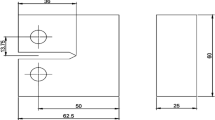Abstract
This paper presents a comprehensive study on fracture mechanics, with a focus on stress intensity factor (SIF) determination, using a combination of experimental, numerical, and empirical methods. The investigation focuses on the creation of an improved finite element model using the AL2014 alloy, which is commonly used in aerospace and structural engineering. Compact tension (CT) specimens of AL2014 were subjected to fatigue pre-cracking in accordance with ASTM E399 guidelines. The study proposes an empirically modified displacement extrapolation technique for accurate SIF calculation that takes pre-crack conditions into account. The experimental results were used to validate ANSYS numerical simulations. The proposed empirical displacement extrapolation method outperformed traditional finite element analysis and displacement extrapolation in terms of accuracy. For example, the stress intensity factor (K_Q) for Sample 1 was determined experimentally as 28.873 MPam0.5, numerically as 30.44 MPam0.5, and empirically as 29.01 MPam0.5, demonstrating the precision of the new approach. The results demonstrate the empirical equation's ability to predict stress intensity factors with high precision when both initial crack length and pre-crack conditions are taken into account. In terms of accuracy and applicability, the proposed method outperforms traditional approaches, with promising implications for fracture mechanics analysis.














Similar content being viewed by others
References
T.L. Anderson, Fracture Mechanics: Fundamentals and Applications, Fourth Edition, 4th edn. (CRC Press, Boca Raton, 2017)
S.K. Chan, I.S. Tuba, W. Wilson, On the finite element method in linear fracture mechanics. Eng. Fract. Mech. 2, 1–17 (1970)
C.F. Shih, H.G. de Lorenzi, M.D. German, Crack extension modeling with singular quadratic isoparametric elements. Int. J. Fract. 12, 647–651 (1976)
D.M. Parks, A stiffness derivative finite element technique for determination of crack tip stress intensity factors. Int. J. Fract. 10, 487–502 (1974)
H.G. de Lorenzi, Energy release rate calculations by the finite element method. Eng. Fract. Mech. 21, 129–143 (1985)
B. Moran, C.F. Shih, A general treatment of crack tip contour integrals. Int. J. Fract. 35, 295–310 (1987)
A. Zare, E.S.M. Kosari , I. Asadi, A. Bigham, Y. Bigham, Finite element method analysis of stress intensity factor in different edge crack positions, and predicting their correlation using neural network method. Res J Recent Sci 3, 69–73 (2014)
N.R. Mohsin, Comparison between theoretical and numerical solutions for center, single edge and double edge cracked finite element plate subjected to tension stress. Int. J. Mech. Prod. Eng. Res. Dev. 5, 11–20 (2015)
R. Kacianauskas, M. Zenon, V. Zarnovskij, E. Stupak, Three-dimensional correction of the stress intensity factor for plate with a notch. Int. J. Fract. 136, 75–98 (2005)
R.S. Barsoum, Application of quadratic isoparametric finite elements in linear fracture mechanics. Int. J. Fract. 10, 603–605 (1974)
ASTM E399-12e3 2012 Standard Test Method for Linear-Elastic Plane-Strain Fracture Toughness KIc of Metallic Materials ASTM International: West Conshohocken, PA, USA
M.P. Ariza, A. Sfiez, J. Dominguez, A singular element for three-dimensional fracture mechanics analysis. Eng. Anal. Boundary Elem. 20, 275–285 (1997)
A.R. Ingraffea, C. Manu, Stress intensity factor computation in three dimensions with quarter point elements. Int. J. Numer. Methods Eng. 15, 1427–1445 (1980)
L.J. Kirthan, V.A. Ramakrishna Hegde, R.G. Girisha Kumar, Evaluation of mode 1 stress intensity factor for edge crack using displacement extrapolation method. Int. J. Materials and Structural Integrity 10, 11–22 (2016)
R.D. Henshell, K.G. Shaw, Crack tip finite elements are unnecessary. Int. J. Numer. Meth. Eng. 9, 495–507 (1975)
M.F. Kanninen, C.H. Popelar, Advanced fracture mechanics (Oxford University Press, New York, 1985)
U. Gupta, L.J. Kirthan, R. Hegde, V.L.J. Guptha, M.M. Math, Assessment of fatigue crack growth on compact tensile mild steel specimen under sudden load, 8-2023, PP 312–320.
M.A. Kattimani, P.R. Venkatesh, H. Masum, M.M. MatH, Design and numerical analysis of tensile deformation and fracture properties of induction hardened inconel 718 superalloy for gas turbine applications. Int. J. Interactive Des. Manufact. (IJIDeM), pp 1–11 (2023).
Funding
This research work has not received any funding.
Author information
Authors and Affiliations
Corresponding author
Ethics declarations
Competing of interest
The authors affirm that there are no discernible conflicting financial interests or personal affiliations that could potentially be perceived as exerting an influence on the findings presented in this manuscript.
Additional information
Publisher's Note
Springer Nature remains neutral with regard to jurisdictional claims in published maps and institutional affiliations.
Rights and permissions
Springer Nature or its licensor (e.g. a society or other partner) holds exclusive rights to this article under a publishing agreement with the author(s) or other rightsholder(s); author self-archiving of the accepted manuscript version of this article is solely governed by the terms of such publishing agreement and applicable law.
About this article
Cite this article
Jabiulla, S., Kirthan, L.J., Kumar, R.G. et al. Experimental and Numerical Evaluation of In-plane Tensile Mode Stress Intensity Factor for Edge Crack Using Empirical Formulation of Displacement Extrapolation Method. J. Inst. Eng. India Ser. D (2024). https://doi.org/10.1007/s40033-024-00640-9
Received:
Accepted:
Published:
DOI: https://doi.org/10.1007/s40033-024-00640-9




